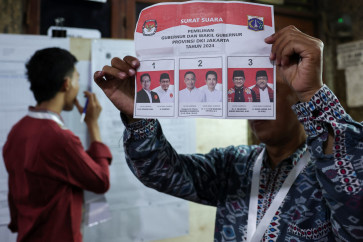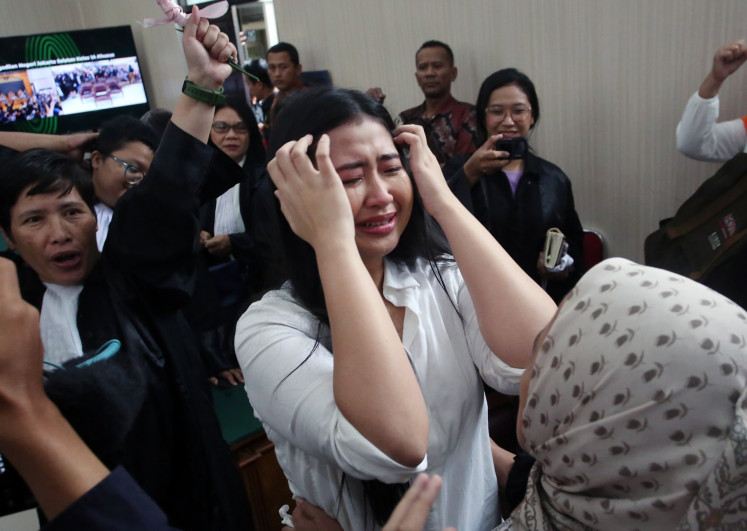Popular Reads
Top Results
Can't find what you're looking for?
View all search resultsPopular Reads
Top Results
Can't find what you're looking for?
View all search resultsMerdi Sihombing: Weaving an adventure
(JP/Ricky Yudhistira) Merdi Sihombing declares proudly that he has a bit of a nationalist streak
Change text size
Gift Premium Articles
to Anyone
(JP/Ricky Yudhistira)
Merdi Sihombing declares proudly that he has a bit of a nationalist streak. The onetime designer of the va-va-voom bustiers favored by entertainers has found his calling in reviving the tradition of woven arts.
Batik is where it's at today in its much-trumpeted embracing by designers and their socialite devotees, but Merdi Sihombing knows there is much more to be found in the treasure trove of traditional fabrics of the archipelago.
Ikat, weavings, embroideries -- no, batik is not the be all and end all of what the nation has to offer.
"Batik, batik, batik," says the designer, who half-jokingly reproves me for addressing him by the Javanese term of mas. "I don't agree with that. Indonesia's weavings are even richer than batik."
But he does take heart from the success of the drive to modernize batik, to take it out of stuffy closets and give it a more youthful, fun, dare we say trendy revamping. The nationalist in him says that it is better this way than letting foreign designers borrow a little here and there from Indonesia's traditional wears while they get scant attention at home.
For it fits into his objectives, too. Five years ago, he created Forbidden Badui, a collection centered on the traditional weavings of the little-known tribe of West Java. In early May, at a glittering event at the Hotel Mulia Senayan, he launched his Partonun (meaning "weaver woman") collection showcasing the ulos (woven fabric) of his own North Sumatran heritage.
The slight designer with the piercing dark eyes brims with passion when he talks about his "adventure" of trying to preserve and promote traditional fabrics; his eyes widen and he gestures floridly when he has a particularly important point to get across.
(JP/Ricky Yudhistira)
"Do you think I'm crazy?" he asks.
It has been an adventure to get where he is today. Born to a Batak policeman father and a Dutch-Ambonese seamstress mother, Merdi says he inherited a love and talent for the arts from his parents. He could draw, dance and sing, winning singing contests in his youth and playing in a band (a tattoo of an ant on his right forearm is from those carefree days).
"I always set targets for myself, that I would have to be a successful singer by such and such an age," he says. "As a man, I also had to think about earning a living... eventually, (singer and good friend) Yuni Shara said, "why don't you try to be a designer?'"
He studied fashion design first; he notes with obvious pride that is not one of the designers who was born into a family with the financial capital to bankroll his interests. "It's not so much about talent here, but having the money, so you can do things like invite the people to your show. I started from zero," he says.
He calls his initial concept "underwear on the outside" -- lingerie, with a focus on bustiers. Today, everybody knows the "l" word, but back then it was the strait-laced Soeharto era of the early 1990s.
"It was a real challenge," says Merdi, whose first client was Yuni.
(JP/Ricky Yudhistira)
"My clothes were rejected by all the magazine editors. But then (men's magazine) Popular used them, and things started to take off."
He then went into kebaya (traditional women's blouses), using stretch fabric and discarded materials from East Asian textile operations. Again it raised his profile.
From there, his nationalistic pride emerged and he set out to learn more about Indonesian textile traditions. He says he always wanted to learn, to try new adventures, not simply stay cooped up in a studio and fret over his next collection.
He was intrigued by the Badui, traveling to the villages of the "outer" people who can have contact with the outside world to study their weaving technique and use of natural dyes.
It would seem a natural fit for him to follow up that exploration with ulos, the traditional fabric of his forefathers, but it proved more difficult than expected. For one, there was the problem of reaching remote areas to find out more about the traditional motifs and weaving. Merdi sometimes hitched a ride on rickety cargo boats to arrive in time for market day.
"I would get there, and people would recognize that I'm Batak, and they would ask about my marga (clan name). But they couldn't understand why I couldn't speak the dialect. I learned gradually."
(JP/Ricky Yudhistira)
He was midway through gathering research when he was invited to present his findings to cellulose fiber producer PT South Pacific Viscose, a subsidiary of Lenzing of Austria. That led to cooperation in using environmentally friendly viscose and Tencel yarn for a softer ulos and songket compared to coarser cotton yarn.
Despite its attractive strong earth tones and striking patterns (as Niessen points out, the use of a center field for motifs is in keeping with designs found in other parts of Southeast Asia), ulos is perhaps one of the lesser known gems of Indonesian traditional cloth. It may have to do with reticence about using it outside of its important ceremonial function within Batak society and culture.
In Batak Cloth and Clothing: A Dynamic Indonesian Tradition (Oxford University Press, Kuala Lumpur, 1993), Sandra Niessen writes that weavings were a form of "national dress" for the Batak people, signifying at first sight their background and clan. Each ulos also has its own special meaning, with different woven fabrics reserved for respective rites of passage. It's not uncommon for Batak people themselves to recount their own clothing faux pas, such as unwittingly wearing a funeral ulos to a wedding.
(JP/Ricky Yudhistira)
Merdi says he was careful to respect tradition, including in using only white (signifying the heavens or spirituality), red (the middle or real world) and black (the "world below") in the ulos. But he was not entrapped by those traditions, choosing to use motifs outside the traditional central section to adorn the whole piece of fabric, and also incorporating Swarovski crystals in place of ceramic beads.
He let his creative rein free in the stunningly gorgeous songket, in a rainbow of azure blues, teal and puce and other vibrant hues (the collection uses natural, plant-based dyes).
In a way, his willingness to adapt to changing times is not new in the Batak tradition; Niessen concludes, "Traditional is a concept the Batak manipulate according to their present needs. *They* live fully in their present world. They continue to skillfully manipulate their appearance according to their changing needs of self-identification."
The show was a success, with many observers saying they saw ulos in a new light. It's already been a long and interesting journey (Merdi says he has met "his soulmate" in one of the women weavers), but he is moving on to new fields of discovery. Next year he plans to visit the forest people of Jambi.
"Yes, I am Batak, but I'm an Indonesian. And there is so much to learn about," he says.














